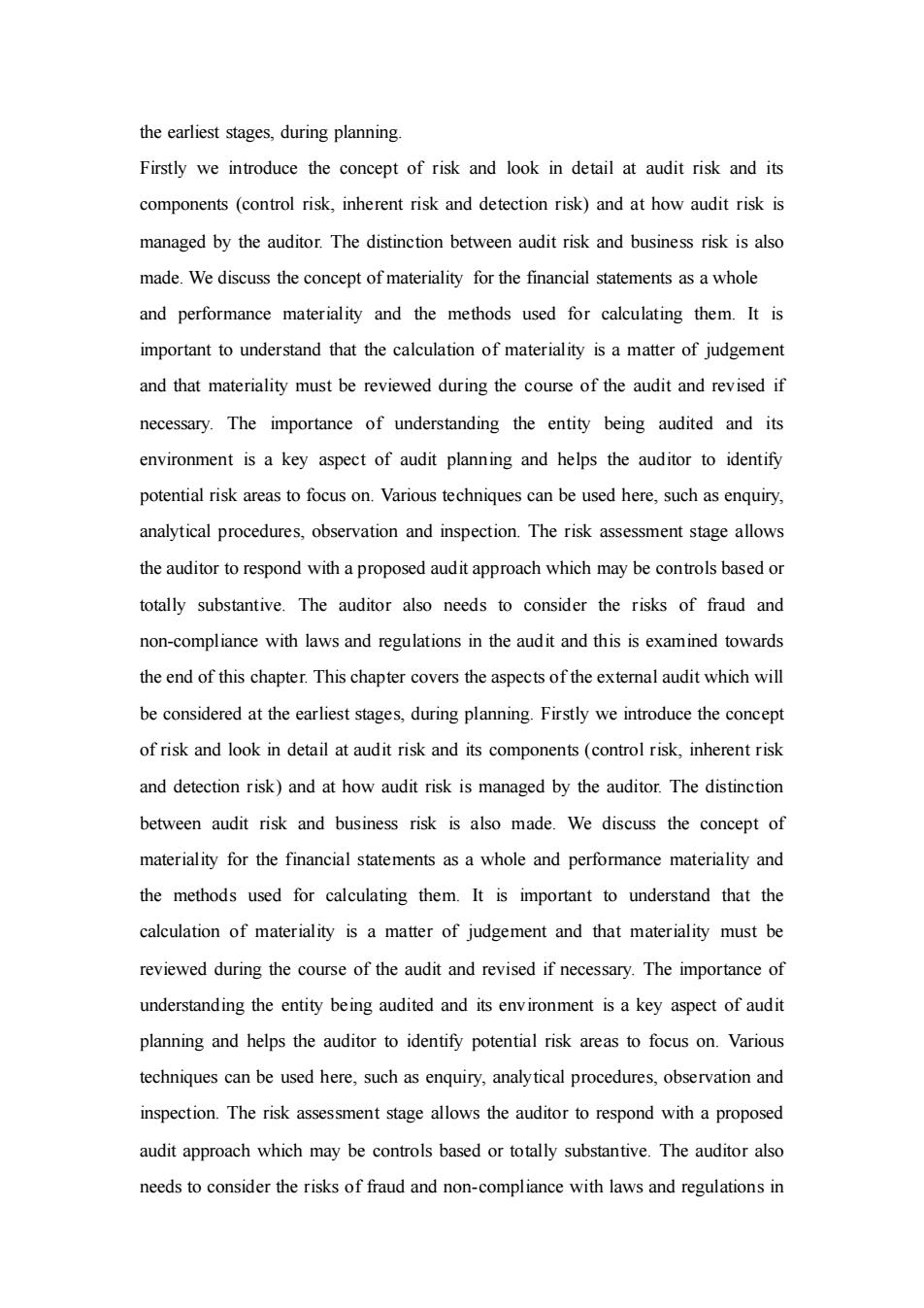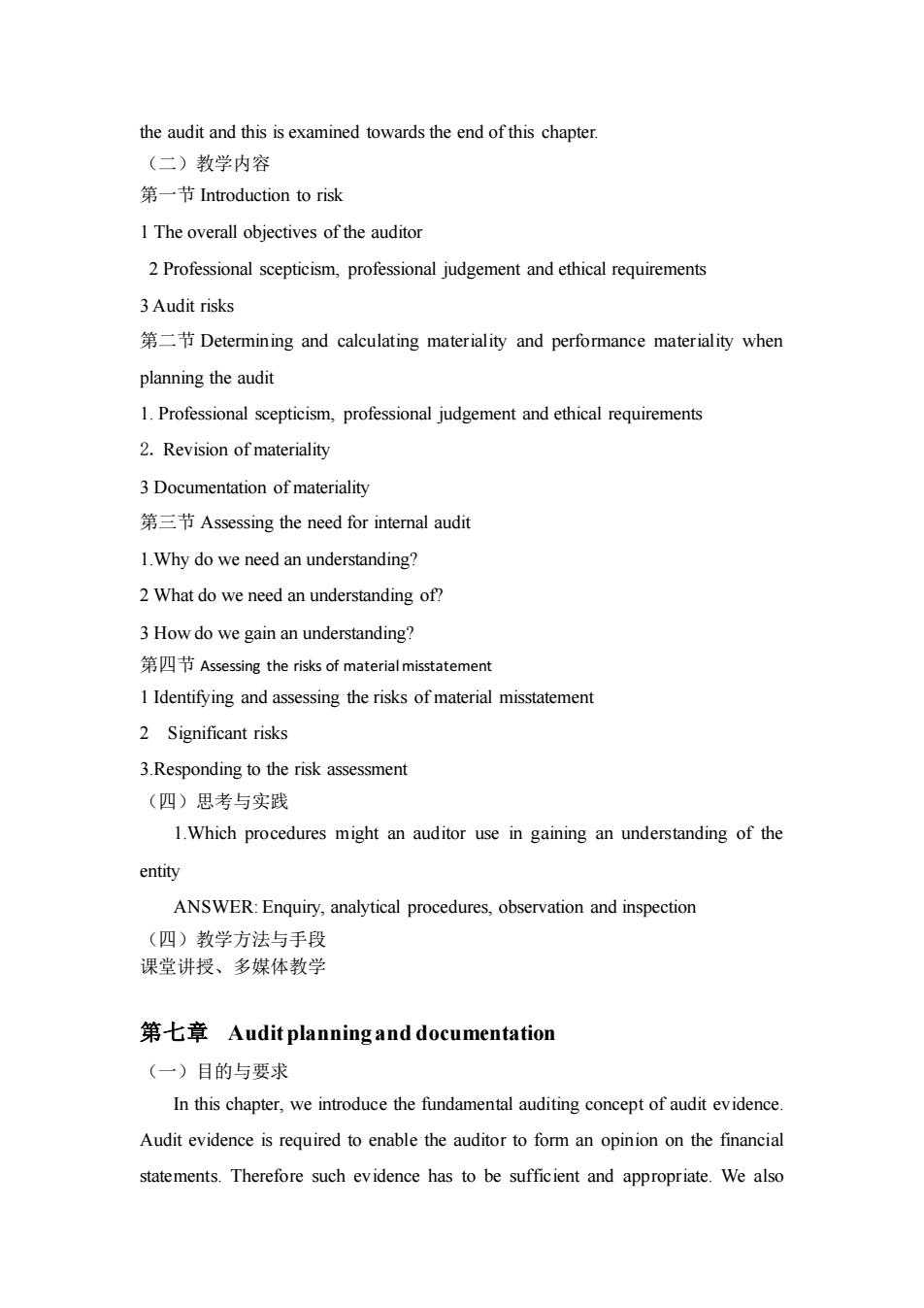
the earliest stages,during planning. Firstly we introduce the concept of risk and look in detail at audit risk and its components (control risk,inherent risk and detection risk)and at how audit risk is managed by the auditor.The distinction between audit risk and business risk is also made.We discuss the concept of materiality for the financial statements as a whole and performance materiality and the methods used for calculating them.It is important to understand that the calculation of materiality is a matter of judgement and that materiality must be reviewed during the course of the audit and revised if necessary.The importance of understanding the entity being audited and its environment is a key aspect of audit planning and helps the auditor to identify potential risk areas to focus on.Various techniques can be used here,such as enquiry, analytical procedures,observation and inspection.The risk assessment stage allows theaditor to respond itha proped audit approach which may be nasedor otally substantive.The auditor also needs to consider the risks of fraud and non-compliance with laws and regulations in the audit and this is examined towards the end of this chapter.This chapter covers the aspects of the external audit which will of risk and look in detail at audit risk and its components(control risk,inherent risk and detection risk)and at how audit risk is managed by the auditor.The distinction between audit risk and business risk is also made.We discuss the concept of materiality for the financial statements as a whole and performance materiality and the methods used for calculating them.It is important to understand that the calculation of materiality is a matter of judgement and that materiality must be reviewed during the course of the audit and revised if necessary.The importance of understanding the entity being audited and its environment is a key aspect of audit planning and helps the auditor to identify potential risk areas to focus on.Various techniques can be used here,such as enquiry,analytical procedures,observation and inspection.The risk assessment stage allows the auditor to respond with a proposed audit approach which may be controls based or totally substantive.The auditor also needs to consider the risks of fraud and non-compliance with laws and regulations in
the earliest stages, during planning. Firstly we introduce the concept of risk and look in detail at audit risk and its components (control risk, inherent risk and detection risk) and at how audit risk is managed by the auditor. The distinction between audit risk and business risk is also made. We discuss the concept of materiality for the financial statements as a whole and performance materiality and the methods used for calculating them. It is important to understand that the calculation of materiality is a matter of judgement and that materiality must be reviewed during the course of the audit and revised if necessary. The importance of understanding the entity being audited and its environment is a key aspect of audit planning and helps the auditor to identify potential risk areas to focus on. Various techniques can be used here, such as enquiry, analytical procedures, observation and inspection. The risk assessment stage allows the auditor to respond with a proposed audit approach which may be controls based or totally substantive. The auditor also needs to consider the risks of fraud and non-compliance with laws and regulations in the audit and this is examined towards the end of this chapter. This chapter covers the aspects of the external audit which will be considered at the earliest stages, during planning. Firstly we introduce the concept of risk and look in detail at audit risk and its components (control risk, inherent risk and detection risk) and at how audit risk is managed by the auditor. The distinction between audit risk and business risk is also made. We discuss the concept of materiality for the financial statements as a whole and performance materiality and the methods used for calculating them. It is important to understand that the calculation of materiality is a matter of judgement and that materiality must be reviewed during the course of the audit and revised if necessary. The importance of understanding the entity being audited and its environment is a key aspect of audit planning and helps the auditor to identify potential risk areas to focus on. Various techniques can be used here, such as enquiry, analytical procedures, observation and inspection. The risk assessment stage allows the auditor to respond with a proposed audit approach which may be controls based or totally substantive. The auditor also needs to consider the risks of fraud and non-compliance with laws and regulations in

the audit and this is examined towards the end of this chapter. (二)教学内容 第一节Introduction to risk 1 The overall objectives of the auditor 2 Professional scepticism,professional judgement and ethical requirements 3Audit risks Determining and calculating materiality and performance materiality when planning the audit 1.Professional scepticism,professional judgement and ethical requirements 2.Revision of materiality 3 Documentation of materiality 第三节Assessing the need for intemal audit 1.Why do we need an understanding? 2 What do we need an understanding of? 3 How do we gain an understanding? 第四节Assessing the risks of material misstatement 1Identifying and assessing the risks of material misstatement 2 Significant risks 3.Responding to the risk assessment (四)思考与实践 1.Which procedures might an auditor use in gaining an understanding of the entity ANSWER:Enquiry,analytical procedures,observation and inspection (四)教学方法与手段 课堂讲授、多媒体教学 第七章Audit planning and documentation (一)目的与要求 In this chapter,we introduce the fundamental auditing concept of audit evidence Audit evidence is required to enable the auditor to form an opinion on the financial statements.Therefore such evidence has to be sufficient and appropriate.We also
the audit and this is examined towards the end of this chapter. (二)教学内容 第一节 Introduction to risk 1 The overall objectives of the auditor 2 Professional scepticism, professional judgement and ethical requirements 3 Audit risks 第二节 Determining and calculating materiality and performance materiality when planning the audit 1. Professional scepticism, professional judgement and ethical requirements 2. Revision of materiality 3 Documentation of materiality 第三节 Assessing the need for internal audit 1.Why do we need an understanding? 2 What do we need an understanding of? 3 How do we gain an understanding? 第四节 Assessing the risks of material misstatement 1 Identifying and assessing the risks of material misstatement 2 Significant risks 3.Responding to the risk assessment (四)思考与实践 1.Which procedures might an auditor use in gaining an understanding of the entity ANSWER: Enquiry, analytical procedures, observation and inspection (四)教学方法与手段 课堂讲授、多媒体教学 第七章 Audit planning and documentation (一)目的与要求 In this chapter, we introduce the fundamental auditing concept of audit evidence. Audit evidence is required to enable the auditor to form an opinion on the financial statements. Therefore such evidence has to be sufficient and appropriate. We also